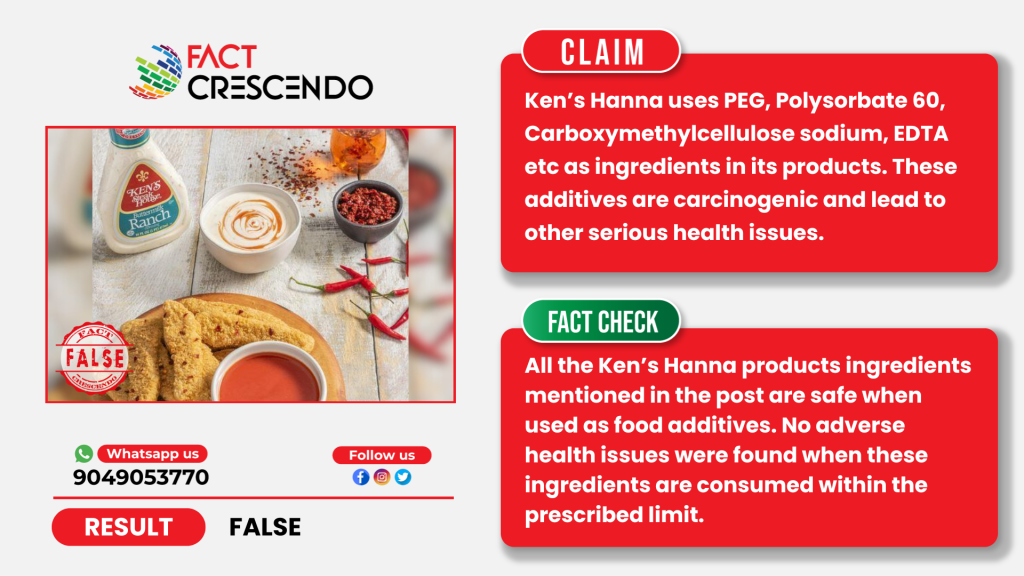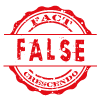
Ken’s Salad dressing is a well-loved brand known for its rich flavors and high-quality ingredients. It offers a variety of options to enhance any salad. Ken’s started as a steakhouse but grew to be one of the lovable brands.
But, some recent social media posts raised concerns over the consumption of the products of this brand which contain harmful ingredients like PEG, Polysorbate, Propylene Glycol, Sorbitol etc.
However, Fact Crescendo found the claim to be false.
What’s the claim?
Social media users are claiming that ingredients like PEG, Polysorbate, Propylene Glycol, Sorbitol, Xylitol, Carboxymethylcellulose, EDTA which are carcinogens and impact the intestinal microbiota leading to various inflammatory diseases.
Fact Check-
Lets check each of the ingredients mentioned in the post whether they are carcinogenic and lead to adverse health issues.
PEG: The EFSA Panel checked the safety of polyethylene glycol (PEG, E 1521) as a food additive using existing data. It is allowed as a food supplement in the European Union, and past studies found no health risks at normal intake levels. The highest estimated intake was 3.5 mg/kg per day for children and 6.1 mg/kg per day for the elderly, which is within safe limits. As only a few food products contain this additive, so the actual intake of this by a person is much lower than the prescribed limits. The panel concluded that polyethylene glycol (E 1521) is safe, but they may need to review it again if its use changes.
Polysorbate 60: According to the Code of Federal Regulation’s report, Polysorbate 60 is made by combining stearic and palmitic acids with sorbitol and polyoxyethylene. It helps mix ingredients like oil and water and is used in various food products. It is approved for safe use in certain foods. The regulatory body has set limits on the use of Polysorbate 60 in different foods. For example, in cakes and cake mixes, it cannot be more than 0.46% of the dry weight. In icings and fillings, the total amount should not exceed 1% when mixed with similar emulsifiers. These rules ensure Polysorbate 60 is used safely in food.
FDA has also approved the use of Polysorbate 60 as food additive and categorised it as Generally Recognized as Safe (GRAS).
Propylene Glycol: According to the CDC, Propylene glycol is approved for use in food, cosmetics, and medicine at safe levels. Most people are exposed to it by eating, using skincare products, or taking medicine, but these small amounts are not harmful. Workers in industries using propylene glycol may touch or breathe it in, but exposure is usually low.
According to the National Library of Medicine, propylene glycol is a synthetic liquid that absorbs water and is used in many industries. It helps keep food, medicine, and cosmetics moist, acts as a solvent for flavors and colors, and is used as antifreeze when food contact is possible. The FDA considers it safe for use in food. It is also used to make polyester, deicing solutions, and artificial smoke for fire training and theater shows.
According to another report, the U.S. FDA has classified propylene glycol as Generally Recognized as Safe (GRAS) for use in food. It can be added directly to food but with certain limits. It is used in food as a stabilizer, thickener, flavoring agent, emulsifier, anticaking agent, and antioxidant, among other purposes. It is also approved for indirect food contact, meaning it can be used in food packaging, coatings, adhesives, and paper products etc.
Sorbitol: Sorbitol is a type of sugar alcohol that has been classified as Generally Recognized as Safe (GRAS) by the FDA for use in foods. It is produced by hydrogenating sugar solutions containing glucose or fructose. Sorbitol serves various functions in food products, including acting as a sweetener, flavoring agent, and texturizer. It must meet specific purity standards as outlined in the Food Chemicals Codex. It has been approved to be used in various food categories as long as it complies with proper manufacturing practices.
The European Food Safety Authority (EFSA) has reviewed sorbitol before and considers it safe to eat within certain limits. However, EFSA is seeking more information to check if sorbitol could cause genetic damage (genotoxicity). They are asking scientists and companies to send in new safety data, especially a test that checks for possible chromosome damage in cells.
Xylitol: Xylitol is a food additive that can be used in different foods as long as it follows good manufacturing practices (GMP). It is listed in Table 3 of the Codex General Standard for Food Additives (GSFA) and is allowed in heat-treated buttermilk and spices, even though they are not specifically mentioned. Xylitol is approved for foods that meet certain Codex standards and works as an emulsifier, humectant, stabilizer, sweetener, and thickener.
The use of Xylitol as both an additive and a sweetener was discussed in the European Parliament. Despite scientific evidence confirming its safety, lower calorie content than sugar, and dental health benefits, the EU Regulation permitted xylitol to be used freely as a food additive, but not as a sweetener. The WHO/FAO expert committee (JECFA) has even stated that there is no specific limit on how much xylitol can be safely consumed when used for its intended purpose.
However, a few questions were also raised in the Parliament seeking clarification on why xylitol can be used without restriction as an additive, yet cannot be used as a sweetener. Additionally, companies may want to know if they can request special approval for its use as a sweetener.
Carboxymethylcellulose: Carboxymethylcellulose sodium (CMC) is a water-soluble gum derived from cellulose through esterification and etherification processes. It serves as a thickener, emulsifier, stabilizer, and water absorber, making it valuable in various industries, including food production. According to Code of Federal Regulations, this is generally recognized as safe (GRAS) when used in accordance with good manufacturing practice.
In 2018, the EFSA Panel on Food Additives reviewed the safety of sodium carboxymethyl cellulose (E466) as a food additive. Later, another EFSA panel (FAF) was asked to check if the additive is safe for infants under 16 weeks old in special medical foods. It was stated that E466 is not used for infants under 16 weeks, so no safety assessment was done for this group. Additionally, companies did not provide enough biological and toxicology data to assess its safety for young children in special medical foods. Since little new information was available, EFSA confirmed its earlier conclusion that there is not enough data to determine the safety of E466 for infants and young children.
EDTA: Ethylenediaminetetraacetic acid (EDTA) and its derivatives, such as calcium disodium EDTA and disodium EDTA, are approved as food additives by the U.S. Food and Drug Administration (FDA). These compounds are utilized for their ability to bind metals, which helps preserve food quality and extend shelf life. The limitation set by the food regulatory agencies for EDTA is 75 parts per million in salad dressing, mayonnaise, sauces etc.
FDA approved the use of EDTA and its forms as food additives and categorised it Generally Recognized as Safe. Below you can see different ETDA and its uses.
Conclusion:
Fact Crescendo found the claim to be false. All the ingredients in the post are safe when used as food additives. No adverse health issues were found when these ingredients are consumed within the prescribed limit. So, Ken’s Hanna products are not carcinogenic and are safe to consume.



